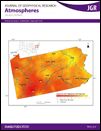Iavorivska et al., 2017
Wet atmospheric deposition of organic carbon: An under-reported source of carbon to watersheds in the northeastern USA.
Iavorivska L, EW Boyer, and JW Grimm (2017)
Journal of Geophysical Research - Atmospheres, 122, 3104-3115
-
Boulder, Christina, Luquillo, Shale Hills, Sierra, INVESTIGATOR
Abstract
We measured wet atmospheric deposition of dissolved organic carbon (DOC) over 6 years at a network of 12 monitoring sites across Pennsylvania, quantified rates of wet DOC deposition, and developed the first statewide estimates of inputs of DOC to watersheds via wet deposition. Average annual volume-weighted concentration of DOC was 0.71 mg C L-1. Annual wet deposition fluxes of DOC varied between sites and years, ranging from 3 to 13 kg C ha-1 yr-1, with an average value of 8 kg C ha-1 yr-1 across all sites and years and are of the same order of magnitude as literature values for riverine organic carbon fluxes in the northeastern United States. The rates of wet DOC deposition showed a pronounced seasonality and spatial distribution, with highest deposition rates observed in the summer, especially at the sites located in western Pennsylvania. Significant links between DOC and inorganic constituents in precipitation, such as sulfate and inorganic nitrogen forms, point to the similarity of sources and atmospheric processing and suggest that DOC may potentially affect their atmospheric transport and ecological fate. Observational data resulting from this study underscore the potential significance of atmospheric deposition as an external input of reactive carbon species to watersheds and may be useful for constraining atmospheric carbon models and evaluating atmospheric influences on ecosystems.
Citation
Iavorivska L, EW Boyer, and JW Grimm (2017): Wet atmospheric deposition of organic carbon: An under-reported source of carbon to watersheds in the northeastern USA. Journal of Geophysical Research - Atmospheres, 122, 3104-3115. DOI: 10.1002/2016JD026027
Explore Further


